Starbuck’s Bubble Tea Marketing Plan Essay
VerifiedAdded on 2023/06/10
|11
|3239
|170
AI Summary
This marketing plan essay discusses the introduction of bubble tea by Starbucks in New Zealand, including market analysis, competition, market segmentation, pricing, distribution, and promotion strategies.
Contribute Materials
Your contribution can guide someone’s learning journey. Share your
documents today.
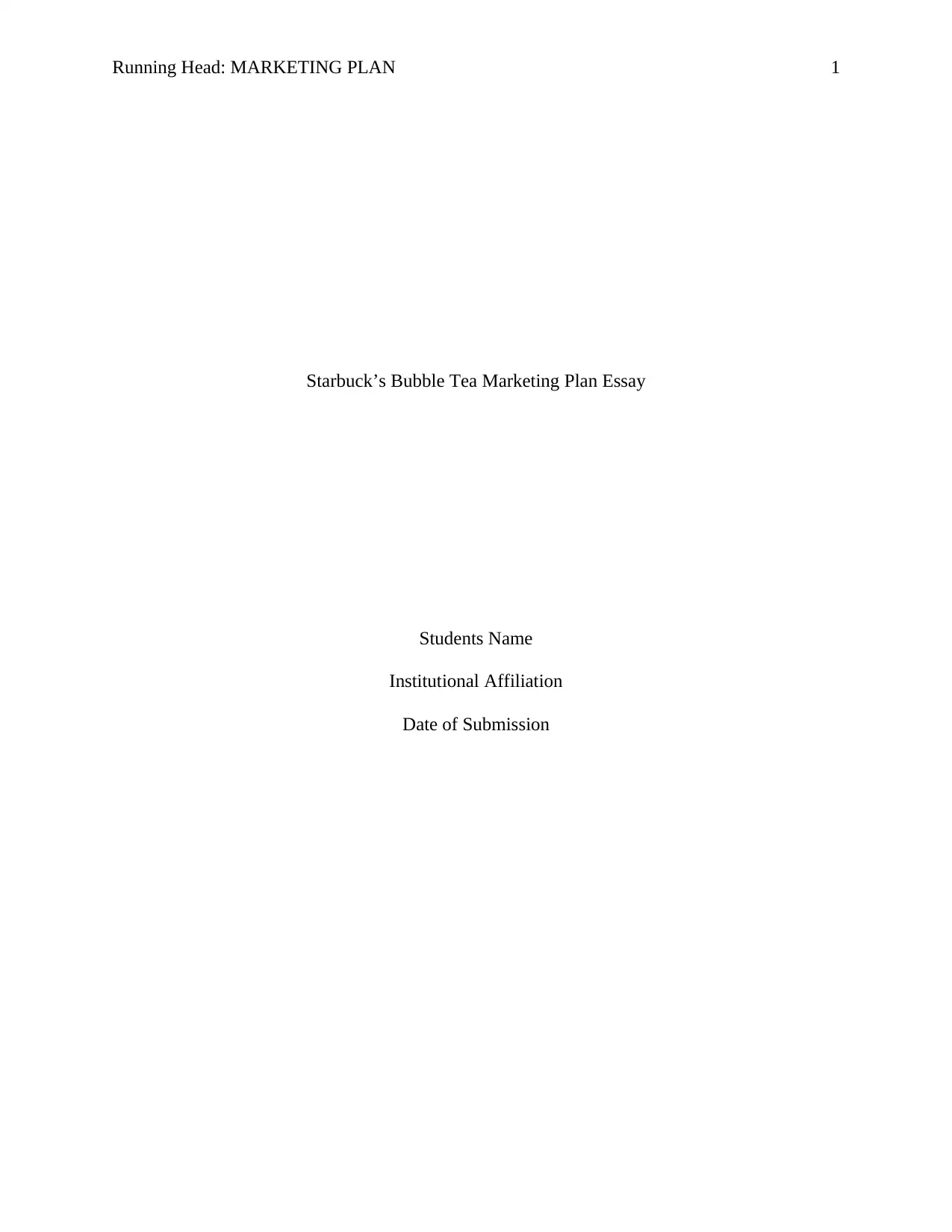
Running Head: MARKETING PLAN 1
Starbuck’s Bubble Tea Marketing Plan Essay
Students Name
Institutional Affiliation
Date of Submission
Starbuck’s Bubble Tea Marketing Plan Essay
Students Name
Institutional Affiliation
Date of Submission
Secure Best Marks with AI Grader
Need help grading? Try our AI Grader for instant feedback on your assignments.

MARKETING PLAN 2
Executive Summary
New Zealand is a country with a small population of slightly over 4.6 million people. The
country is filled with the many individuals who are seeking education, work, and living. Most of
the individuals are from different countries like Asia and the Pacific Islands. Their income levels
are moderate as compared to other populations. Starbucks has asked the manager to prepare a
marketing plan for a new product that is being introduced in the market that is called the bubble
tea. The beverage is made from tea base which is mixed with fruits. Alternatively, it can be made
from fruit flavors and blended ice versions of tea. Most people in the country love hanging out
and having tea or coffee or any beverage. Most young single adults take most of their time in
such places seeking to find partners and making new friends. Also, in such places, people who
are dating can be found relaxing and enjoying the environment and the music that soothes the
soul.
Starbucks has competition, and their operations are noticed by many rivals who also want
a share or already have a share of the market. There is Dunkin Donuts, Coca-Cola, Pepsi and
McDonalds who have given the company a hard time in the region. However, with the new
product, the company can outsmart them and gain a more significant market share than the
existing. Bubble tea is unique in the region and many people who know the product will be
excited on hearing it's being brought into the country. Besides that, the company and the new
product are bound to be hit by internal and external environmental forces like the completion,
legal and labor factors which if remain unchecked they may cost the company a fortune. The
paper will also be addressing the strategic market plans for the product regarding the product,
price, place (distribution) and promotion and also the integration and linking of the market mix.
Executive Summary
New Zealand is a country with a small population of slightly over 4.6 million people. The
country is filled with the many individuals who are seeking education, work, and living. Most of
the individuals are from different countries like Asia and the Pacific Islands. Their income levels
are moderate as compared to other populations. Starbucks has asked the manager to prepare a
marketing plan for a new product that is being introduced in the market that is called the bubble
tea. The beverage is made from tea base which is mixed with fruits. Alternatively, it can be made
from fruit flavors and blended ice versions of tea. Most people in the country love hanging out
and having tea or coffee or any beverage. Most young single adults take most of their time in
such places seeking to find partners and making new friends. Also, in such places, people who
are dating can be found relaxing and enjoying the environment and the music that soothes the
soul.
Starbucks has competition, and their operations are noticed by many rivals who also want
a share or already have a share of the market. There is Dunkin Donuts, Coca-Cola, Pepsi and
McDonalds who have given the company a hard time in the region. However, with the new
product, the company can outsmart them and gain a more significant market share than the
existing. Bubble tea is unique in the region and many people who know the product will be
excited on hearing it's being brought into the country. Besides that, the company and the new
product are bound to be hit by internal and external environmental forces like the completion,
legal and labor factors which if remain unchecked they may cost the company a fortune. The
paper will also be addressing the strategic market plans for the product regarding the product,
price, place (distribution) and promotion and also the integration and linking of the market mix.
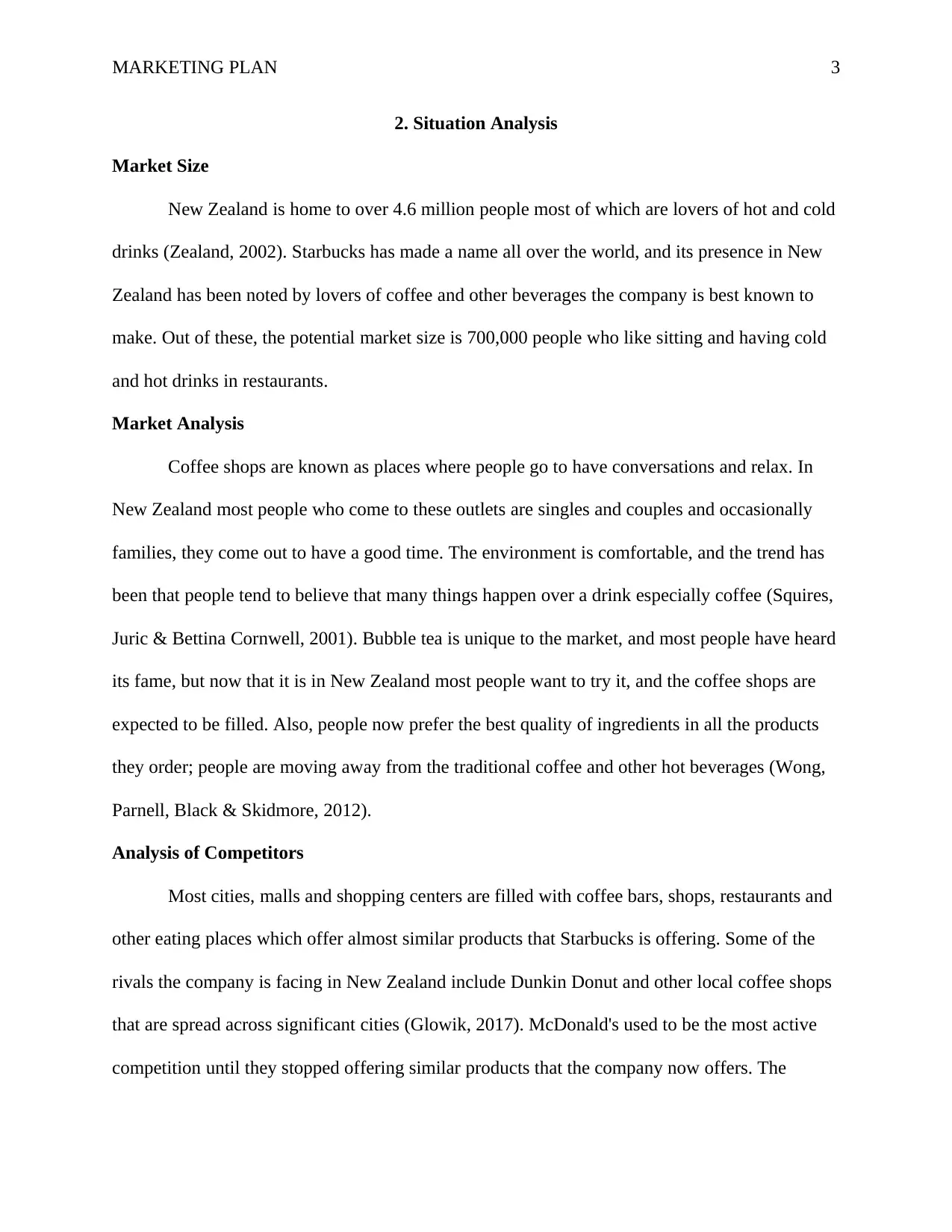
MARKETING PLAN 3
2. Situation Analysis
Market Size
New Zealand is home to over 4.6 million people most of which are lovers of hot and cold
drinks (Zealand, 2002). Starbucks has made a name all over the world, and its presence in New
Zealand has been noted by lovers of coffee and other beverages the company is best known to
make. Out of these, the potential market size is 700,000 people who like sitting and having cold
and hot drinks in restaurants.
Market Analysis
Coffee shops are known as places where people go to have conversations and relax. In
New Zealand most people who come to these outlets are singles and couples and occasionally
families, they come out to have a good time. The environment is comfortable, and the trend has
been that people tend to believe that many things happen over a drink especially coffee (Squires,
Juric & Bettina Cornwell, 2001). Bubble tea is unique to the market, and most people have heard
its fame, but now that it is in New Zealand most people want to try it, and the coffee shops are
expected to be filled. Also, people now prefer the best quality of ingredients in all the products
they order; people are moving away from the traditional coffee and other hot beverages (Wong,
Parnell, Black & Skidmore, 2012).
Analysis of Competitors
Most cities, malls and shopping centers are filled with coffee bars, shops, restaurants and
other eating places which offer almost similar products that Starbucks is offering. Some of the
rivals the company is facing in New Zealand include Dunkin Donut and other local coffee shops
that are spread across significant cities (Glowik, 2017). McDonald's used to be the most active
competition until they stopped offering similar products that the company now offers. The
2. Situation Analysis
Market Size
New Zealand is home to over 4.6 million people most of which are lovers of hot and cold
drinks (Zealand, 2002). Starbucks has made a name all over the world, and its presence in New
Zealand has been noted by lovers of coffee and other beverages the company is best known to
make. Out of these, the potential market size is 700,000 people who like sitting and having cold
and hot drinks in restaurants.
Market Analysis
Coffee shops are known as places where people go to have conversations and relax. In
New Zealand most people who come to these outlets are singles and couples and occasionally
families, they come out to have a good time. The environment is comfortable, and the trend has
been that people tend to believe that many things happen over a drink especially coffee (Squires,
Juric & Bettina Cornwell, 2001). Bubble tea is unique to the market, and most people have heard
its fame, but now that it is in New Zealand most people want to try it, and the coffee shops are
expected to be filled. Also, people now prefer the best quality of ingredients in all the products
they order; people are moving away from the traditional coffee and other hot beverages (Wong,
Parnell, Black & Skidmore, 2012).
Analysis of Competitors
Most cities, malls and shopping centers are filled with coffee bars, shops, restaurants and
other eating places which offer almost similar products that Starbucks is offering. Some of the
rivals the company is facing in New Zealand include Dunkin Donut and other local coffee shops
that are spread across significant cities (Glowik, 2017). McDonald's used to be the most active
competition until they stopped offering similar products that the company now offers. The

MARKETING PLAN 4
competition was intense because of the prices, however, since the Bubble tea is new and the
ingredients are not local the product is likely going to demand high price which will see the
competition come back again. However, because of its uniqueness, international goodwill, and
public demand, Starbucks’ Bubble tea will outwit the competition (Honack & Waikar, 2017).
Internal Environment Analysis
Resources will be among the things that might slow down the marketing of this new
product (Grant, 2016). There is not enough human resource to conduct a nationwide campaign
and marketing for the Bubble tea. The actual labor is fully committed, and the allocated funds
cannot allow hiring enough staff to achieve the company’s goal (Fleisher & Bensoussan, 2015).
Besides that, there is the company’s culture which is most employees don’t like changes, any
shift from the routine could upset the whole system and slow down the process of marketing.
External Environment Analysis
The recent tax policies that have been introduced by the government could cut into moist
of the profits gained from the sale of the product. If they are implemented and made law, the
company will have to part with close to 3% of its profits from the sales. Also, with the low
market entry barriers, more competitors have eyed this vast market and have begun trickling in
which will force the company to share its market share with the competition. Besides that, the
fluctuating exchange rates will also eat into the profits, with the dollar being unstable in the
recent times, the threat is real (Moutinho & Phillips, 2018).
3. Market Segmentation, Profile of the Target Market and Positioning of the Product
Market Segmentation
The segmentation base applicable to the product is demographic, under this, there are three
variable to consider namely, marital status, social status and income level. For the marital status,
competition was intense because of the prices, however, since the Bubble tea is new and the
ingredients are not local the product is likely going to demand high price which will see the
competition come back again. However, because of its uniqueness, international goodwill, and
public demand, Starbucks’ Bubble tea will outwit the competition (Honack & Waikar, 2017).
Internal Environment Analysis
Resources will be among the things that might slow down the marketing of this new
product (Grant, 2016). There is not enough human resource to conduct a nationwide campaign
and marketing for the Bubble tea. The actual labor is fully committed, and the allocated funds
cannot allow hiring enough staff to achieve the company’s goal (Fleisher & Bensoussan, 2015).
Besides that, there is the company’s culture which is most employees don’t like changes, any
shift from the routine could upset the whole system and slow down the process of marketing.
External Environment Analysis
The recent tax policies that have been introduced by the government could cut into moist
of the profits gained from the sale of the product. If they are implemented and made law, the
company will have to part with close to 3% of its profits from the sales. Also, with the low
market entry barriers, more competitors have eyed this vast market and have begun trickling in
which will force the company to share its market share with the competition. Besides that, the
fluctuating exchange rates will also eat into the profits, with the dollar being unstable in the
recent times, the threat is real (Moutinho & Phillips, 2018).
3. Market Segmentation, Profile of the Target Market and Positioning of the Product
Market Segmentation
The segmentation base applicable to the product is demographic, under this, there are three
variable to consider namely, marital status, social status and income level. For the marital status,
Secure Best Marks with AI Grader
Need help grading? Try our AI Grader for instant feedback on your assignments.
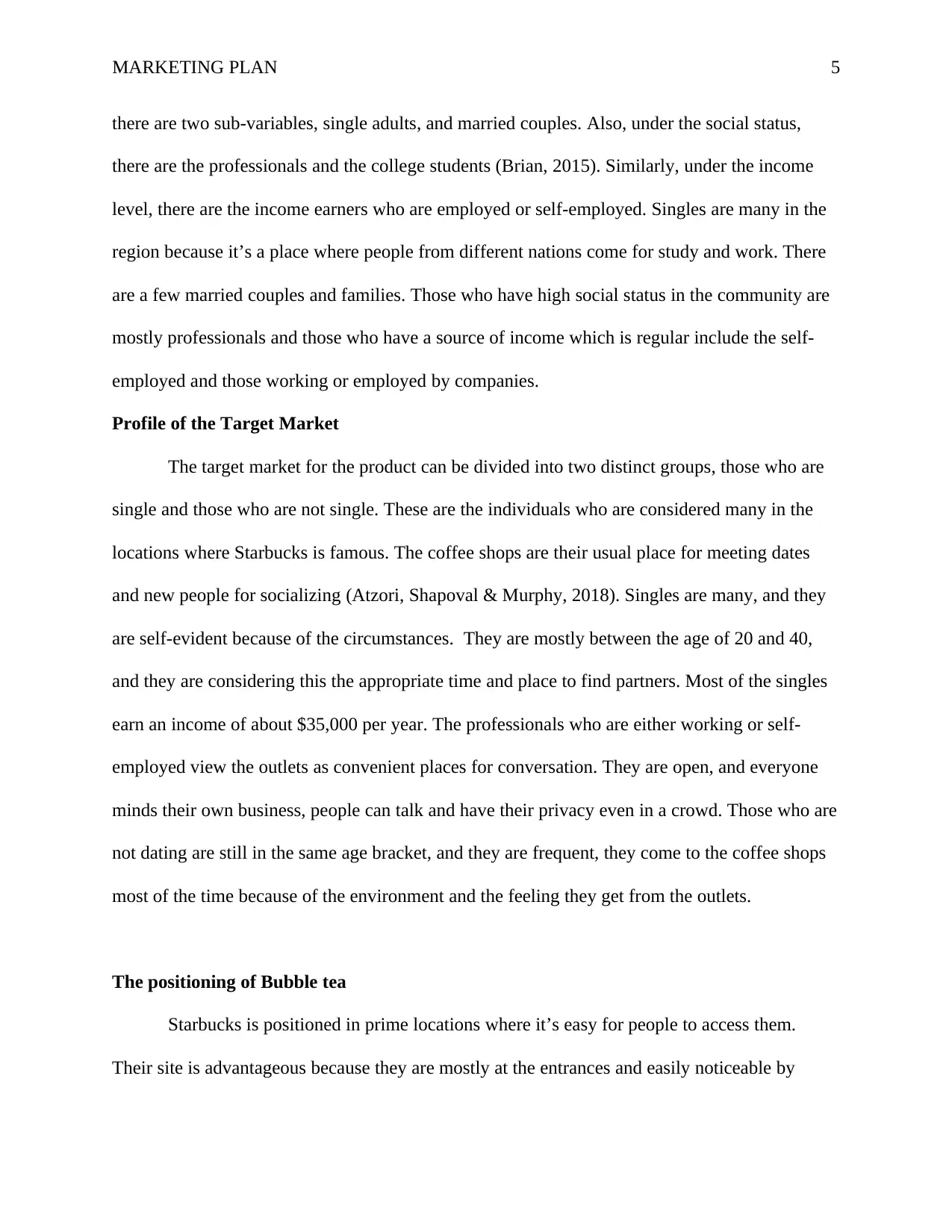
MARKETING PLAN 5
there are two sub-variables, single adults, and married couples. Also, under the social status,
there are the professionals and the college students (Brian, 2015). Similarly, under the income
level, there are the income earners who are employed or self-employed. Singles are many in the
region because it’s a place where people from different nations come for study and work. There
are a few married couples and families. Those who have high social status in the community are
mostly professionals and those who have a source of income which is regular include the self-
employed and those working or employed by companies.
Profile of the Target Market
The target market for the product can be divided into two distinct groups, those who are
single and those who are not single. These are the individuals who are considered many in the
locations where Starbucks is famous. The coffee shops are their usual place for meeting dates
and new people for socializing (Atzori, Shapoval & Murphy, 2018). Singles are many, and they
are self-evident because of the circumstances. They are mostly between the age of 20 and 40,
and they are considering this the appropriate time and place to find partners. Most of the singles
earn an income of about $35,000 per year. The professionals who are either working or self-
employed view the outlets as convenient places for conversation. They are open, and everyone
minds their own business, people can talk and have their privacy even in a crowd. Those who are
not dating are still in the same age bracket, and they are frequent, they come to the coffee shops
most of the time because of the environment and the feeling they get from the outlets.
The positioning of Bubble tea
Starbucks is positioned in prime locations where it’s easy for people to access them.
Their site is advantageous because they are mostly at the entrances and easily noticeable by
there are two sub-variables, single adults, and married couples. Also, under the social status,
there are the professionals and the college students (Brian, 2015). Similarly, under the income
level, there are the income earners who are employed or self-employed. Singles are many in the
region because it’s a place where people from different nations come for study and work. There
are a few married couples and families. Those who have high social status in the community are
mostly professionals and those who have a source of income which is regular include the self-
employed and those working or employed by companies.
Profile of the Target Market
The target market for the product can be divided into two distinct groups, those who are
single and those who are not single. These are the individuals who are considered many in the
locations where Starbucks is famous. The coffee shops are their usual place for meeting dates
and new people for socializing (Atzori, Shapoval & Murphy, 2018). Singles are many, and they
are self-evident because of the circumstances. They are mostly between the age of 20 and 40,
and they are considering this the appropriate time and place to find partners. Most of the singles
earn an income of about $35,000 per year. The professionals who are either working or self-
employed view the outlets as convenient places for conversation. They are open, and everyone
minds their own business, people can talk and have their privacy even in a crowd. Those who are
not dating are still in the same age bracket, and they are frequent, they come to the coffee shops
most of the time because of the environment and the feeling they get from the outlets.
The positioning of Bubble tea
Starbucks is positioned in prime locations where it’s easy for people to access them.
Their site is advantageous because they are mostly at the entrances and easily noticeable by
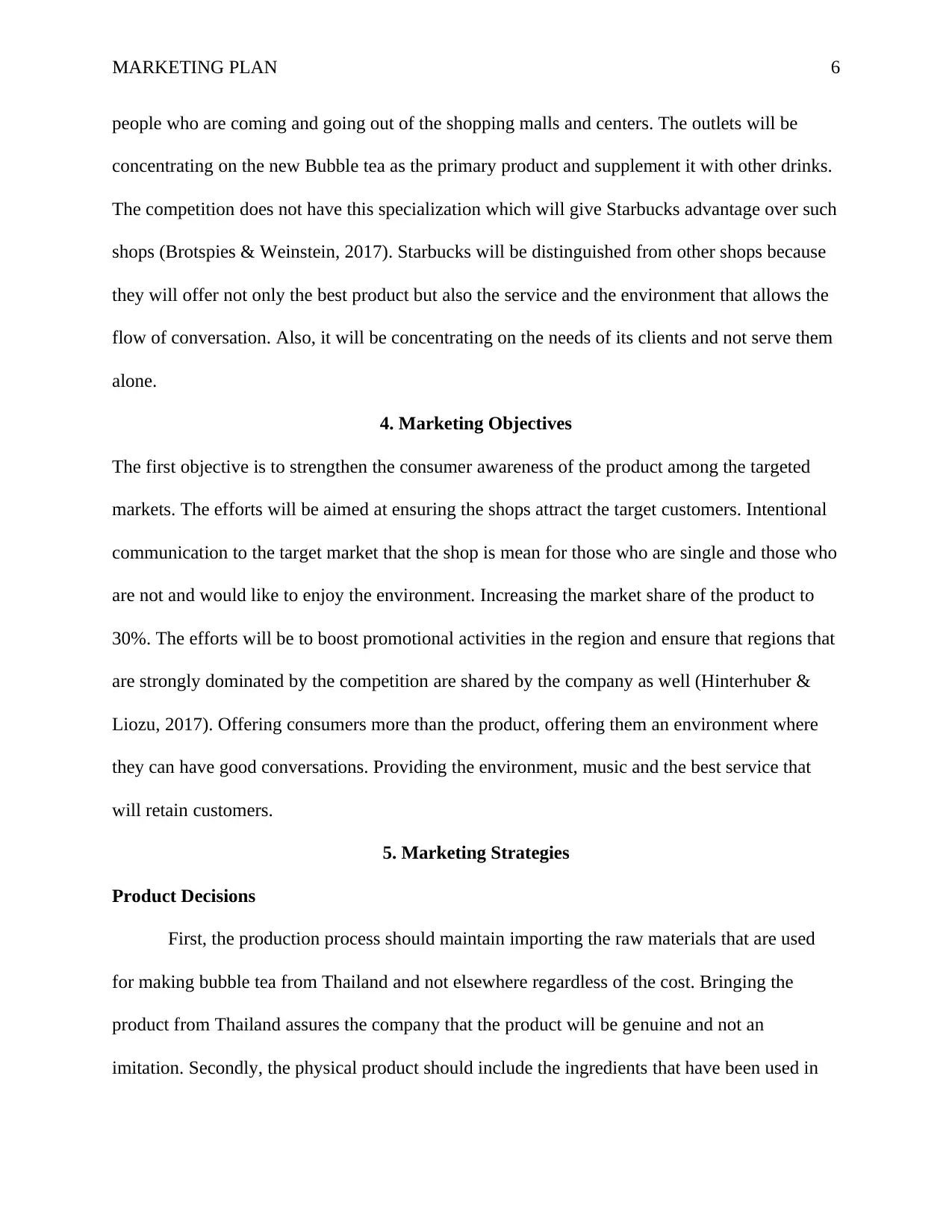
MARKETING PLAN 6
people who are coming and going out of the shopping malls and centers. The outlets will be
concentrating on the new Bubble tea as the primary product and supplement it with other drinks.
The competition does not have this specialization which will give Starbucks advantage over such
shops (Brotspies & Weinstein, 2017). Starbucks will be distinguished from other shops because
they will offer not only the best product but also the service and the environment that allows the
flow of conversation. Also, it will be concentrating on the needs of its clients and not serve them
alone.
4. Marketing Objectives
The first objective is to strengthen the consumer awareness of the product among the targeted
markets. The efforts will be aimed at ensuring the shops attract the target customers. Intentional
communication to the target market that the shop is mean for those who are single and those who
are not and would like to enjoy the environment. Increasing the market share of the product to
30%. The efforts will be to boost promotional activities in the region and ensure that regions that
are strongly dominated by the competition are shared by the company as well (Hinterhuber &
Liozu, 2017). Offering consumers more than the product, offering them an environment where
they can have good conversations. Providing the environment, music and the best service that
will retain customers.
5. Marketing Strategies
Product Decisions
First, the production process should maintain importing the raw materials that are used
for making bubble tea from Thailand and not elsewhere regardless of the cost. Bringing the
product from Thailand assures the company that the product will be genuine and not an
imitation. Secondly, the physical product should include the ingredients that have been used in
people who are coming and going out of the shopping malls and centers. The outlets will be
concentrating on the new Bubble tea as the primary product and supplement it with other drinks.
The competition does not have this specialization which will give Starbucks advantage over such
shops (Brotspies & Weinstein, 2017). Starbucks will be distinguished from other shops because
they will offer not only the best product but also the service and the environment that allows the
flow of conversation. Also, it will be concentrating on the needs of its clients and not serve them
alone.
4. Marketing Objectives
The first objective is to strengthen the consumer awareness of the product among the targeted
markets. The efforts will be aimed at ensuring the shops attract the target customers. Intentional
communication to the target market that the shop is mean for those who are single and those who
are not and would like to enjoy the environment. Increasing the market share of the product to
30%. The efforts will be to boost promotional activities in the region and ensure that regions that
are strongly dominated by the competition are shared by the company as well (Hinterhuber &
Liozu, 2017). Offering consumers more than the product, offering them an environment where
they can have good conversations. Providing the environment, music and the best service that
will retain customers.
5. Marketing Strategies
Product Decisions
First, the production process should maintain importing the raw materials that are used
for making bubble tea from Thailand and not elsewhere regardless of the cost. Bringing the
product from Thailand assures the company that the product will be genuine and not an
imitation. Secondly, the physical product should include the ingredients that have been used in
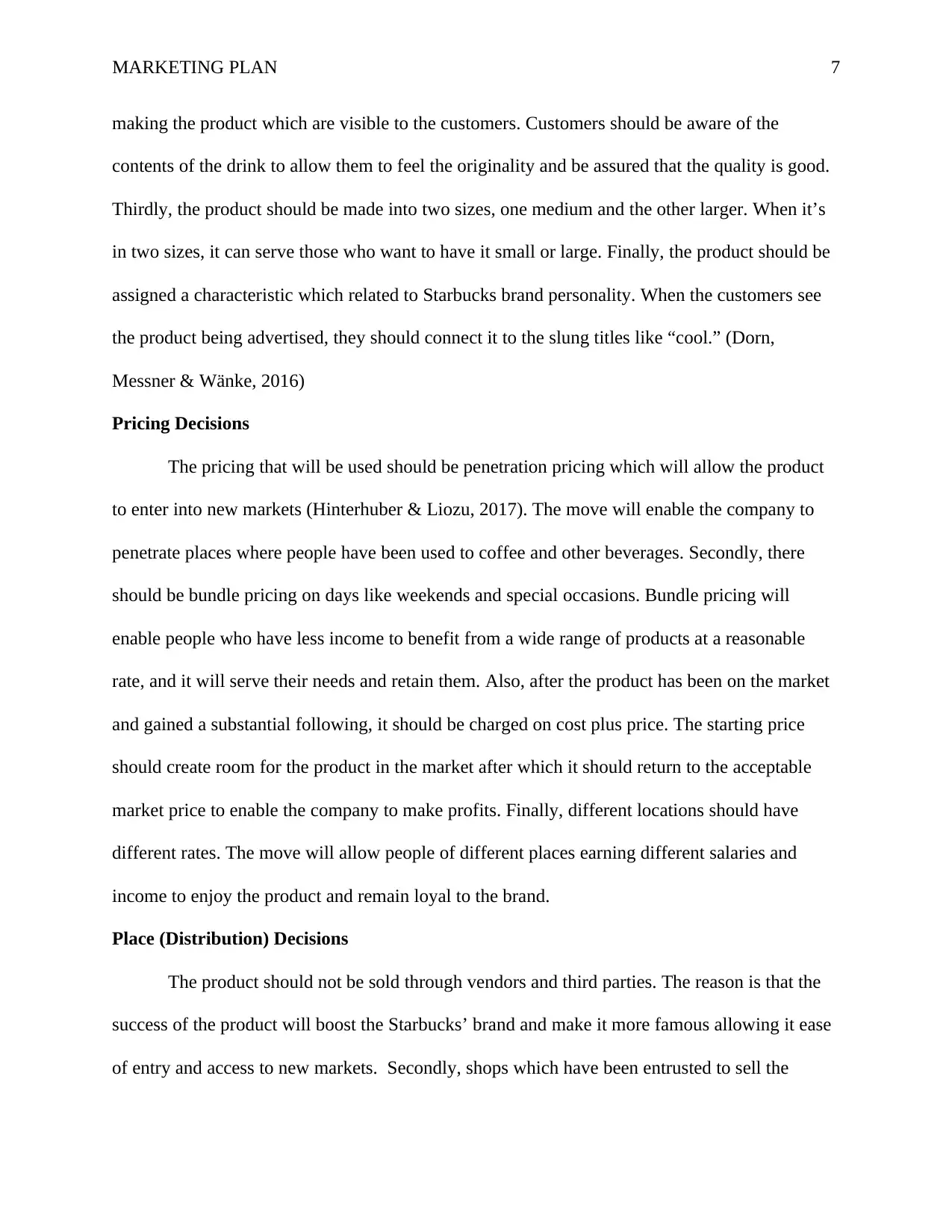
MARKETING PLAN 7
making the product which are visible to the customers. Customers should be aware of the
contents of the drink to allow them to feel the originality and be assured that the quality is good.
Thirdly, the product should be made into two sizes, one medium and the other larger. When it’s
in two sizes, it can serve those who want to have it small or large. Finally, the product should be
assigned a characteristic which related to Starbucks brand personality. When the customers see
the product being advertised, they should connect it to the slung titles like “cool.” (Dorn,
Messner & Wänke, 2016)
Pricing Decisions
The pricing that will be used should be penetration pricing which will allow the product
to enter into new markets (Hinterhuber & Liozu, 2017). The move will enable the company to
penetrate places where people have been used to coffee and other beverages. Secondly, there
should be bundle pricing on days like weekends and special occasions. Bundle pricing will
enable people who have less income to benefit from a wide range of products at a reasonable
rate, and it will serve their needs and retain them. Also, after the product has been on the market
and gained a substantial following, it should be charged on cost plus price. The starting price
should create room for the product in the market after which it should return to the acceptable
market price to enable the company to make profits. Finally, different locations should have
different rates. The move will allow people of different places earning different salaries and
income to enjoy the product and remain loyal to the brand.
Place (Distribution) Decisions
The product should not be sold through vendors and third parties. The reason is that the
success of the product will boost the Starbucks’ brand and make it more famous allowing it ease
of entry and access to new markets. Secondly, shops which have been entrusted to sell the
making the product which are visible to the customers. Customers should be aware of the
contents of the drink to allow them to feel the originality and be assured that the quality is good.
Thirdly, the product should be made into two sizes, one medium and the other larger. When it’s
in two sizes, it can serve those who want to have it small or large. Finally, the product should be
assigned a characteristic which related to Starbucks brand personality. When the customers see
the product being advertised, they should connect it to the slung titles like “cool.” (Dorn,
Messner & Wänke, 2016)
Pricing Decisions
The pricing that will be used should be penetration pricing which will allow the product
to enter into new markets (Hinterhuber & Liozu, 2017). The move will enable the company to
penetrate places where people have been used to coffee and other beverages. Secondly, there
should be bundle pricing on days like weekends and special occasions. Bundle pricing will
enable people who have less income to benefit from a wide range of products at a reasonable
rate, and it will serve their needs and retain them. Also, after the product has been on the market
and gained a substantial following, it should be charged on cost plus price. The starting price
should create room for the product in the market after which it should return to the acceptable
market price to enable the company to make profits. Finally, different locations should have
different rates. The move will allow people of different places earning different salaries and
income to enjoy the product and remain loyal to the brand.
Place (Distribution) Decisions
The product should not be sold through vendors and third parties. The reason is that the
success of the product will boost the Starbucks’ brand and make it more famous allowing it ease
of entry and access to new markets. Secondly, shops which have been entrusted to sell the
Paraphrase This Document
Need a fresh take? Get an instant paraphrase of this document with our AI Paraphraser

MARKETING PLAN 8
product should never run out of the product at any given time; therefore, the supply should be
consistent. The reason is that people who are used to getting the product in those shops when
they miss it once they may start looking for substitutes. Thirdly, shops should be set up in most
cities and at the entry points of shopping malls. The move will allow the product to sell faster
and its fame spread more quickly because of many customers in such places. Finally, crowded
places should have a Starbucks shop or outlets (Steenkamp, 2017). The reason being, people in
crowds, like to isolate themselves when they have something to do or talk about. The presence of
a shop selling Bubble tea would be a good distraction for such people.
Promotional Decisions
The company should strengthen its presence in the media and make the product their
priority on the social media (Wrenn & Mansfield, 2014). The reason is that the social media is
where people meet and start talking and creating events where people on sites like Facebook can
follow can bring sales. Secondly, the product should be promoted through the existing and loyal
Starbucks’ customers. It is because marketing a product using someone who already likes the
product is easier and it’s cheaper. Thirdly, winning over customers from its competition like
Coca Cola, Pepsi, and the likes should be the objective of the company. Because the product is
not hot and there are many cold drinks out there which want attention. Finally, the sales
promotion and marketing tools used should be cheap. The cheap promotion will be necessary
because the product will be selling itself because if its demand and publicity.
Integration and Link
The product and the price can be brought together to take care of the needs of the
customer. The customers should get a product that suits their needs while also in the price range
that does not hurt their pockets. The price and product have a link when the customer sees the
product should never run out of the product at any given time; therefore, the supply should be
consistent. The reason is that people who are used to getting the product in those shops when
they miss it once they may start looking for substitutes. Thirdly, shops should be set up in most
cities and at the entry points of shopping malls. The move will allow the product to sell faster
and its fame spread more quickly because of many customers in such places. Finally, crowded
places should have a Starbucks shop or outlets (Steenkamp, 2017). The reason being, people in
crowds, like to isolate themselves when they have something to do or talk about. The presence of
a shop selling Bubble tea would be a good distraction for such people.
Promotional Decisions
The company should strengthen its presence in the media and make the product their
priority on the social media (Wrenn & Mansfield, 2014). The reason is that the social media is
where people meet and start talking and creating events where people on sites like Facebook can
follow can bring sales. Secondly, the product should be promoted through the existing and loyal
Starbucks’ customers. It is because marketing a product using someone who already likes the
product is easier and it’s cheaper. Thirdly, winning over customers from its competition like
Coca Cola, Pepsi, and the likes should be the objective of the company. Because the product is
not hot and there are many cold drinks out there which want attention. Finally, the sales
promotion and marketing tools used should be cheap. The cheap promotion will be necessary
because the product will be selling itself because if its demand and publicity.
Integration and Link
The product and the price can be brought together to take care of the needs of the
customer. The customers should get a product that suits their needs while also in the price range
that does not hurt their pockets. The price and product have a link when the customer sees the
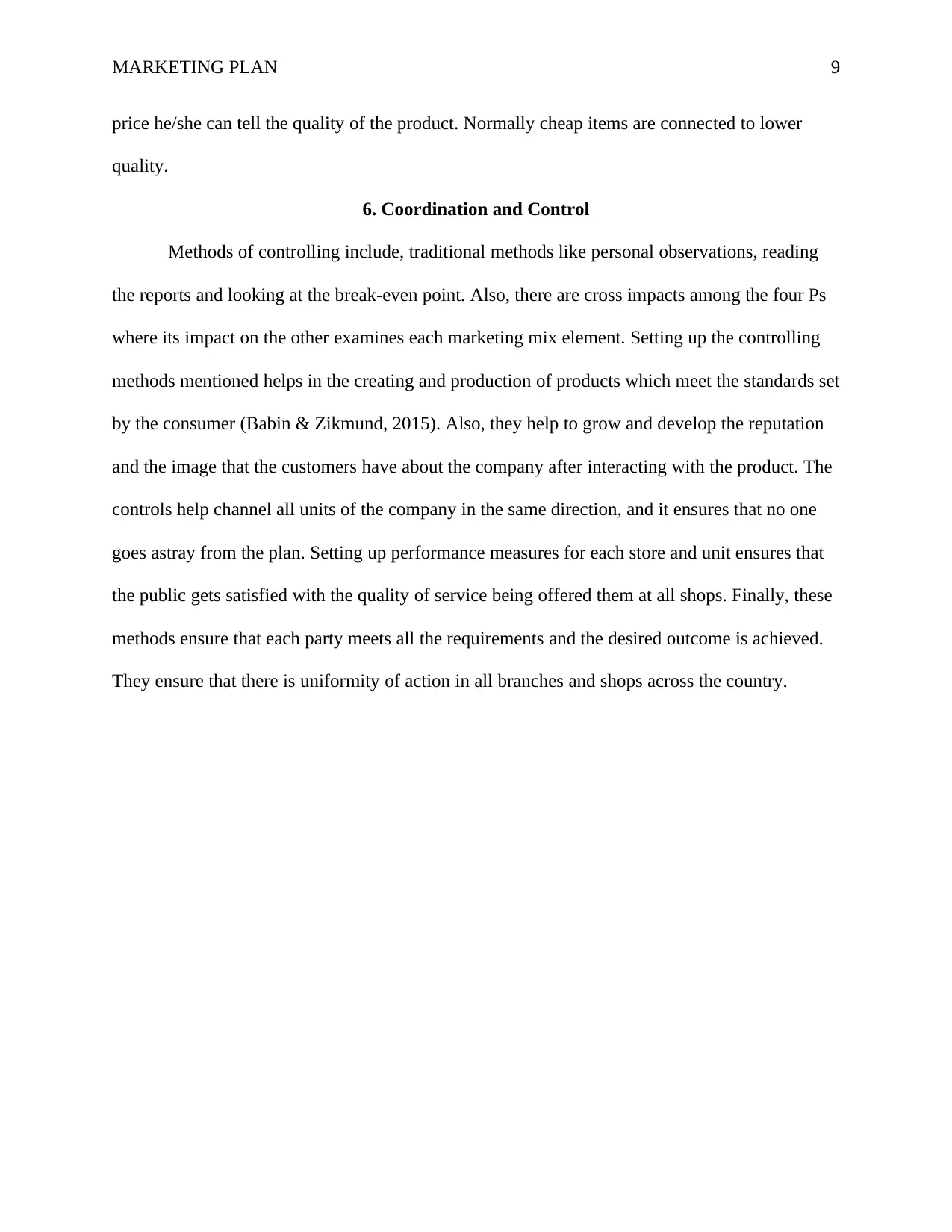
MARKETING PLAN 9
price he/she can tell the quality of the product. Normally cheap items are connected to lower
quality.
6. Coordination and Control
Methods of controlling include, traditional methods like personal observations, reading
the reports and looking at the break-even point. Also, there are cross impacts among the four Ps
where its impact on the other examines each marketing mix element. Setting up the controlling
methods mentioned helps in the creating and production of products which meet the standards set
by the consumer (Babin & Zikmund, 2015). Also, they help to grow and develop the reputation
and the image that the customers have about the company after interacting with the product. The
controls help channel all units of the company in the same direction, and it ensures that no one
goes astray from the plan. Setting up performance measures for each store and unit ensures that
the public gets satisfied with the quality of service being offered them at all shops. Finally, these
methods ensure that each party meets all the requirements and the desired outcome is achieved.
They ensure that there is uniformity of action in all branches and shops across the country.
price he/she can tell the quality of the product. Normally cheap items are connected to lower
quality.
6. Coordination and Control
Methods of controlling include, traditional methods like personal observations, reading
the reports and looking at the break-even point. Also, there are cross impacts among the four Ps
where its impact on the other examines each marketing mix element. Setting up the controlling
methods mentioned helps in the creating and production of products which meet the standards set
by the consumer (Babin & Zikmund, 2015). Also, they help to grow and develop the reputation
and the image that the customers have about the company after interacting with the product. The
controls help channel all units of the company in the same direction, and it ensures that no one
goes astray from the plan. Setting up performance measures for each store and unit ensures that
the public gets satisfied with the quality of service being offered them at all shops. Finally, these
methods ensure that each party meets all the requirements and the desired outcome is achieved.
They ensure that there is uniformity of action in all branches and shops across the country.
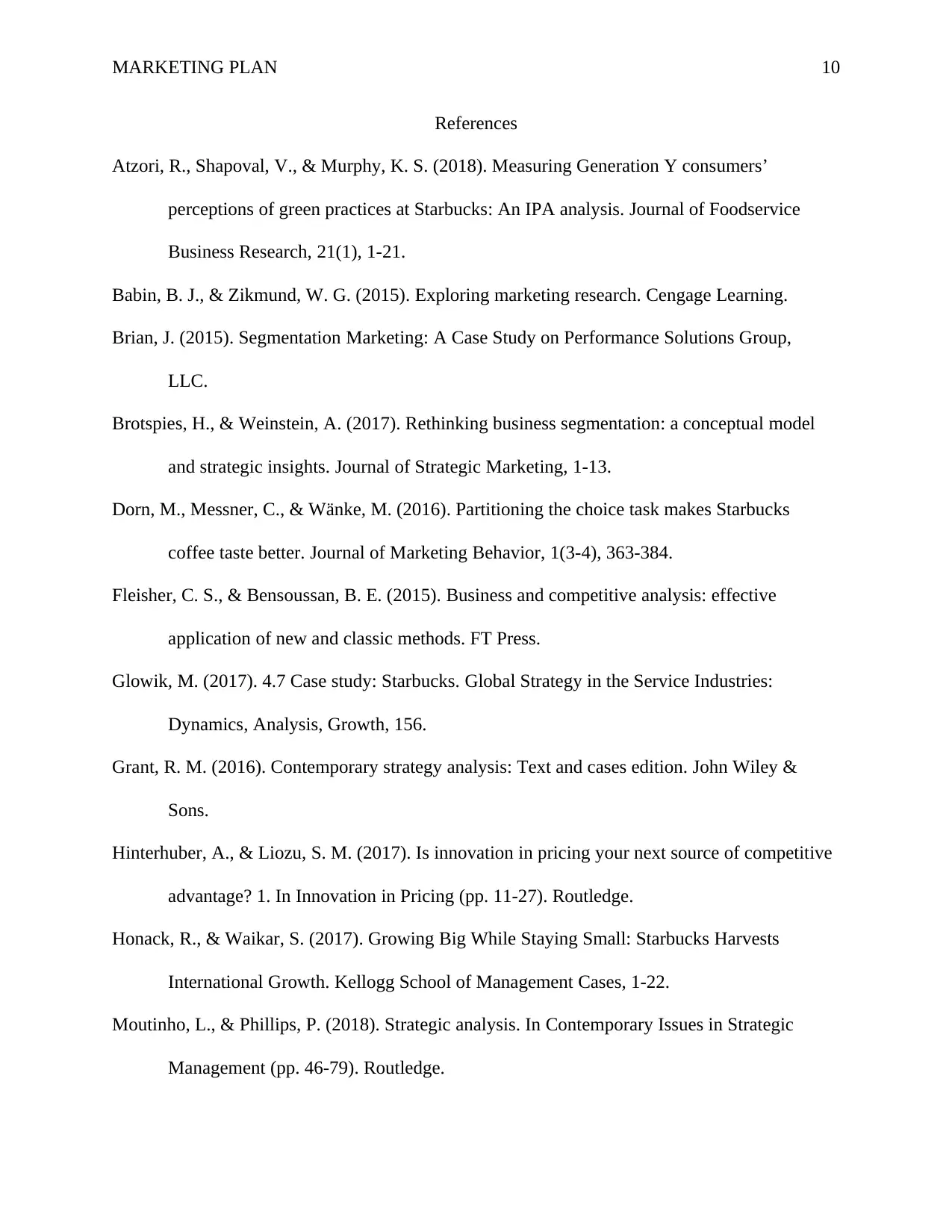
MARKETING PLAN 10
References
Atzori, R., Shapoval, V., & Murphy, K. S. (2018). Measuring Generation Y consumers’
perceptions of green practices at Starbucks: An IPA analysis. Journal of Foodservice
Business Research, 21(1), 1-21.
Babin, B. J., & Zikmund, W. G. (2015). Exploring marketing research. Cengage Learning.
Brian, J. (2015). Segmentation Marketing: A Case Study on Performance Solutions Group,
LLC.
Brotspies, H., & Weinstein, A. (2017). Rethinking business segmentation: a conceptual model
and strategic insights. Journal of Strategic Marketing, 1-13.
Dorn, M., Messner, C., & Wänke, M. (2016). Partitioning the choice task makes Starbucks
coffee taste better. Journal of Marketing Behavior, 1(3-4), 363-384.
Fleisher, C. S., & Bensoussan, B. E. (2015). Business and competitive analysis: effective
application of new and classic methods. FT Press.
Glowik, M. (2017). 4.7 Case study: Starbucks. Global Strategy in the Service Industries:
Dynamics, Analysis, Growth, 156.
Grant, R. M. (2016). Contemporary strategy analysis: Text and cases edition. John Wiley &
Sons.
Hinterhuber, A., & Liozu, S. M. (2017). Is innovation in pricing your next source of competitive
advantage? 1. In Innovation in Pricing (pp. 11-27). Routledge.
Honack, R., & Waikar, S. (2017). Growing Big While Staying Small: Starbucks Harvests
International Growth. Kellogg School of Management Cases, 1-22.
Moutinho, L., & Phillips, P. (2018). Strategic analysis. In Contemporary Issues in Strategic
Management (pp. 46-79). Routledge.
References
Atzori, R., Shapoval, V., & Murphy, K. S. (2018). Measuring Generation Y consumers’
perceptions of green practices at Starbucks: An IPA analysis. Journal of Foodservice
Business Research, 21(1), 1-21.
Babin, B. J., & Zikmund, W. G. (2015). Exploring marketing research. Cengage Learning.
Brian, J. (2015). Segmentation Marketing: A Case Study on Performance Solutions Group,
LLC.
Brotspies, H., & Weinstein, A. (2017). Rethinking business segmentation: a conceptual model
and strategic insights. Journal of Strategic Marketing, 1-13.
Dorn, M., Messner, C., & Wänke, M. (2016). Partitioning the choice task makes Starbucks
coffee taste better. Journal of Marketing Behavior, 1(3-4), 363-384.
Fleisher, C. S., & Bensoussan, B. E. (2015). Business and competitive analysis: effective
application of new and classic methods. FT Press.
Glowik, M. (2017). 4.7 Case study: Starbucks. Global Strategy in the Service Industries:
Dynamics, Analysis, Growth, 156.
Grant, R. M. (2016). Contemporary strategy analysis: Text and cases edition. John Wiley &
Sons.
Hinterhuber, A., & Liozu, S. M. (2017). Is innovation in pricing your next source of competitive
advantage? 1. In Innovation in Pricing (pp. 11-27). Routledge.
Honack, R., & Waikar, S. (2017). Growing Big While Staying Small: Starbucks Harvests
International Growth. Kellogg School of Management Cases, 1-22.
Moutinho, L., & Phillips, P. (2018). Strategic analysis. In Contemporary Issues in Strategic
Management (pp. 46-79). Routledge.
Secure Best Marks with AI Grader
Need help grading? Try our AI Grader for instant feedback on your assignments.

MARKETING PLAN 11
Squires, L., Juric, B., & Bettina Cornwell, T. (2001). Level of market development and intensity
of organic food consumption: cross-cultural study of Danish and New Zealand
consumers. Journal of Consumer Marketing, 18(5), 392-409.
Steenkamp, J. B. (2017). Global Marketing Mix Decisions: Global Integration, Not
Standardization. In Global Brand Strategy (pp. 75-109). Palgrave Macmillan, London.
Wong, J. E., Parnell, W. R., Black, K. E., & Skidmore, P. M. (2012). Reliability and relative
validity of a food frequency questionnaire to assess food group intakes in New Zealand
adolescents. Nutrition journal, 11(1), 65.
Wrenn, B., & Mansfield, P. M. (2014). Marketing planning guide. Routledge.
Zealand, S. N. (2002). New Zealand census of population and dwellings 2001.
Squires, L., Juric, B., & Bettina Cornwell, T. (2001). Level of market development and intensity
of organic food consumption: cross-cultural study of Danish and New Zealand
consumers. Journal of Consumer Marketing, 18(5), 392-409.
Steenkamp, J. B. (2017). Global Marketing Mix Decisions: Global Integration, Not
Standardization. In Global Brand Strategy (pp. 75-109). Palgrave Macmillan, London.
Wong, J. E., Parnell, W. R., Black, K. E., & Skidmore, P. M. (2012). Reliability and relative
validity of a food frequency questionnaire to assess food group intakes in New Zealand
adolescents. Nutrition journal, 11(1), 65.
Wrenn, B., & Mansfield, P. M. (2014). Marketing planning guide. Routledge.
Zealand, S. N. (2002). New Zealand census of population and dwellings 2001.
1 out of 11
Related Documents
Your All-in-One AI-Powered Toolkit for Academic Success.
+13062052269
info@desklib.com
Available 24*7 on WhatsApp / Email
![[object Object]](/_next/static/media/star-bottom.7253800d.svg)
Unlock your academic potential
© 2024 | Zucol Services PVT LTD | All rights reserved.





